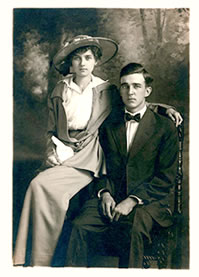Would you believe that people who live with each other for 25 years actually develop similar facial features? I don’t just mean that people tend to choose partners who resemble them, rather that over time together couple’s features actually converge. It’s weird, but there’s evidence for it from a singular study carried out by the noted psychologist Robert Zajonc and colleagues.
Here’s what they did.
110 participants were shown photographs of men and women in their first year of marriage and of the same couples after 25 years of marriage. Then they were asked to judge their resemblance along with the chance that any man and woman were married to each other. The researchers went to a lot of effort to remove extraneous info and crop photos so that only faces could be seen.
The types of choices the participants made indicated the perception was that couples became more facially similar after 25 years together. The results could not be explained by people simply all looking the same as they got older. Also, data from a control group indicated participants were indeed making judgements on the basis of facial features rather than any other criteria.
So this means if you stick around with your partner, you’ll end up looking more like them after a couple of decades. Which naturally raises the question: why?
Here are the possible explanations the authors suggest:
1. Diet. If you share your diet with another person it’s possible this is the cause. For example if both partners eat a high fat diet, both their faces will tend to look chubby. The authors, however, ruled this out using an additional small study.
2. Environment. It could be that it’s because couples live together in the same area. This means that environmental factors such as sunshine and so on affect the skin in similar ways. The authors rule this one out as well because all their married couples came from the same part of the US Midwest and were matched on a number of other socioeconomic variables.
3. Predisposition. This is the idea that people are more likely to choose partners who will grow to look like them. E.g. depressed people are attracted to each other, so end up looking depressed. The authors give this one a maybe, although it is not their favourite option.
4. Empathy. This is the theory the authors like – and so do I. People grow to look similar because they are empathising with each other and so copying each other’s facial expressions. Over time because of all the empathising they are doing, their faces come to look more similar. For example, if one partner often smiles in a particular way, the other is likely to copy it – so creating similar patterns of wrinkles and furrows on the face.
Because they liked theory number 4 the authors had another thought. Why not see if those who grow to look most like each other are the happiest couples? Presumably, then, those who get on better, empathise with each other to a greater degree and therefore go on to look more similar. Unfortunately, this test failed to reach statistical significance, so this study doesn’t give us enough evidence to say whether or not it is true.
A glimpse of the future?
A straw poll of people I’ve talked to about this research reveals a polarised reaction. Some think that growing to look more like your partner is an horrific idea. Others, though, think there’s something very sweet and romantic about it. I think I’m in the latter camp.
There is one worrying possibility this study suggests. It is said if you want to find out what your partner will look like when they’re older, you should look at your partner’s parents. Perhaps a glance at your partner’s parents might also reveal what you will look like in a couple of decades. Truly scary stuff!
» Related: find out whether dogs really resemble their owners.
References
Zajonc, R.B., Adelmann, P.K., Murphy, S.T., & Niedenthal, P.M. (1987). Convergence in the physical appearance of spouses. Motivation and Emotion, 11(4), 335-346.

